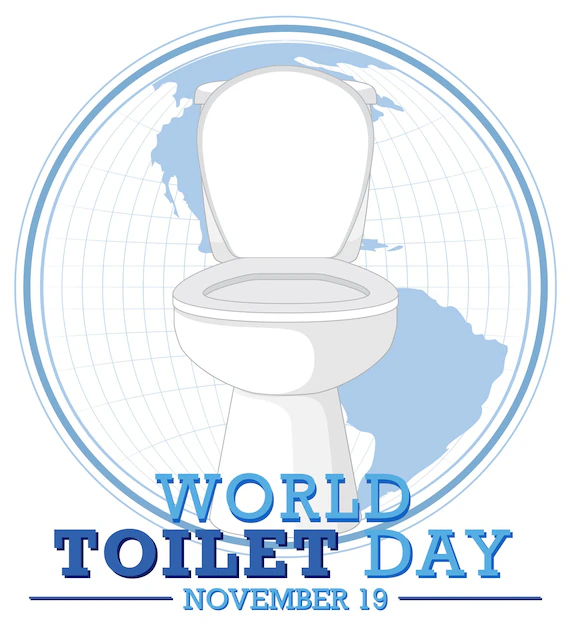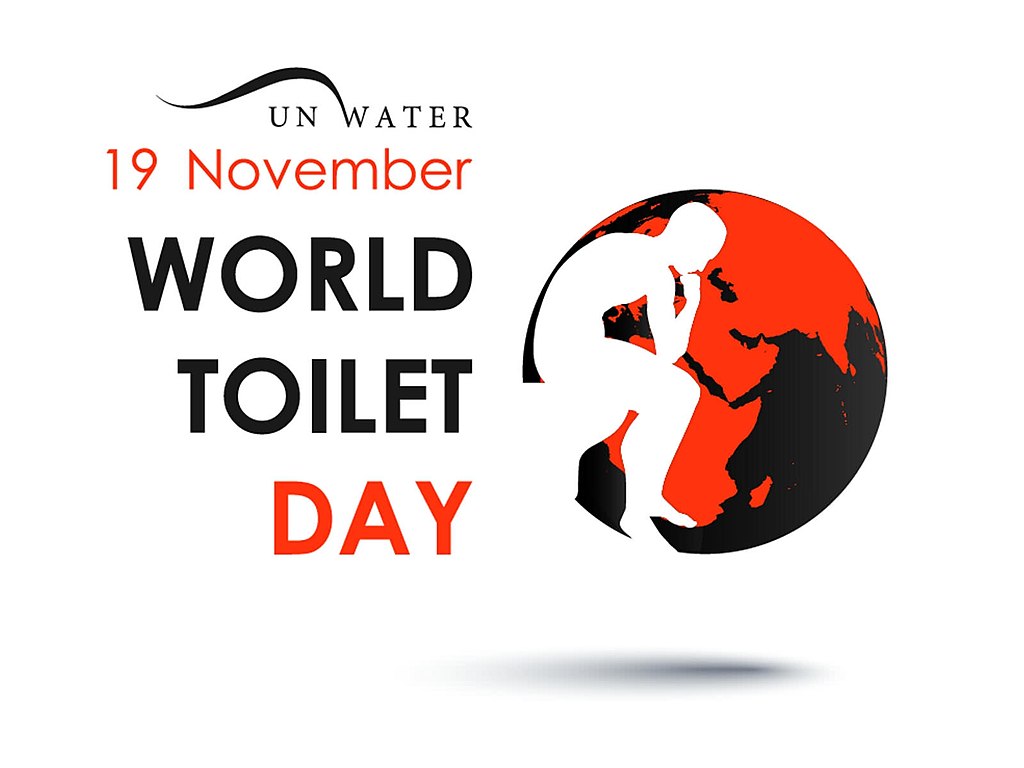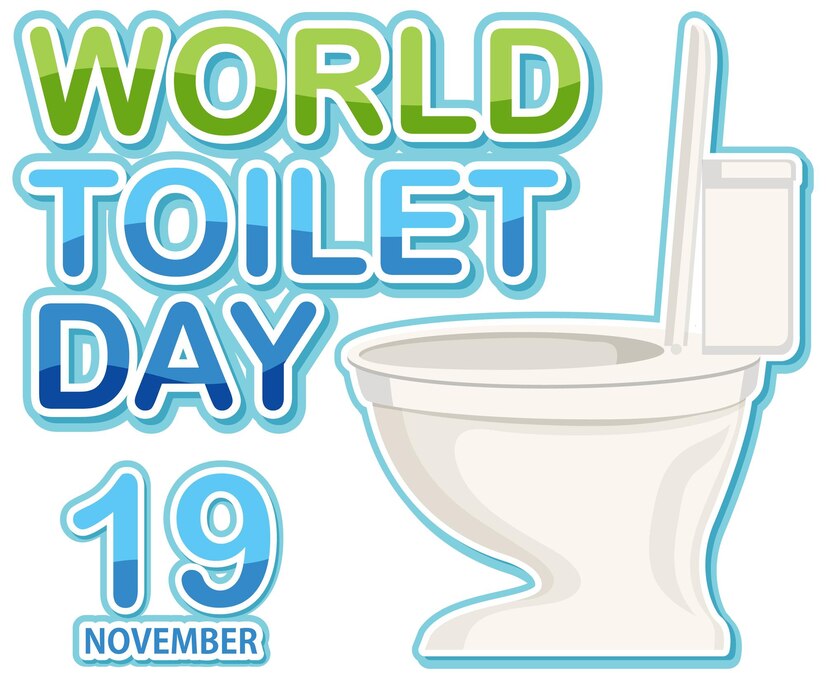Discover the impact of Global Toilet Day with some powerful insights. Join the movement for a cleaner, healthier world!
Global Toilet Day, also known as World Toilet Day or International Toilet Day, observed annually on November 19th, may not be the most glamorous of international observances, but it tackles a fundamental and often overlooked aspect of human well-being—sanitation. In this article, we explore the significance of Global Toilet Day, the global sanitation crisis, innovations in toilet technology, and the various initiatives aimed at improving sanitation worldwide.

History of Global Toilet Day
Global Toilet Day, initially established by the World Toilet Organization in 2001, has since gained global recognition as a day to raise awareness about the critical importance of proper sanitation. Over the years, the day has evolved into a platform for advocating sustainable sanitation practices and addressing the challenges faced by billions of people around the world.
The Global Sanitation Crisis
As shocking as it may sound, billions of people worldwide lack access to basic sanitation facilities. Poor sanitation has severe consequences on public health and the environment. According to recent statistics, approximately 4.2 billion people still live without safely managed sanitation services. The impact is not only felt on an individual level but also contributes to larger global challenges, including the spread of diseases and environmental pollution.
The Role of Clean Toilets in Health
Clean toilets play a pivotal role in preventing the spread of diseases and improving overall community well-being. The simple act of having access to a clean toilet can significantly reduce the risk of waterborne diseases, contributing to the health and vitality of communities. Sanitation is not just a matter of convenience; it’s a cornerstone of public health.
Global Toilet Day: A Call to Action for Sanitation for All
Every year on November 19th, the world observes Global Toilet Day or International Toilet Day, a day dedicated to raising awareness about the importance of sanitation and the 2.4 billion people who lack access to basic sanitation facilities. This year’s theme is “Accelerating Change,” a call to action to urgently address the global sanitation crisis.
The Global Sanitation Crisis
The lack of access to sanitation is a major public health crisis. It is estimated that unsafe sanitation causes 443,000 diarrheal deaths each year, most of which are among children under the age of five. Unsafe sanitation also contributes to the spread of other diseases, such as cholera, typhoid, and hepatitis A.
In addition to its health impacts, the lack of sanitation has a negative impact on education, gender equality, and economic development. Children who lack access to sanitation are more likely to miss school due to illness. Girls are particularly vulnerable to the lack of sanitation, as they may be afraid to use unsafe toilets, leading to them dropping out of school. The lack of sanitation also makes it difficult for women to participate fully in society, as they may have to travel long distances to find a toilet, which can make them feel unsafe and vulnerable.
What Can We Do?
There are a number of things we can do to address the global sanitation crisis.
- Support NGOs, groups who are working and attempting to improve sanitation in developing countries. There are a number of organizations that are working to provide access to sanitation to those who need it most. You can support these organizations by donating money or your time.
- Advocate for government policies that support sanitation. You can contact your elected officials and urge them to support policies that will increase access to sanitation.
- Make changes in your own life. You can make a difference by taking steps to improve your own sanitation habits, such as washing your hands with soap and water after using the toilet and disposing of waste properly.
The Significance of Global Toilet Day
Global Toilet Day, observed on November 19th each year, serves as a crucial platform to galvanize global attention towards the critical role of sanitation in promoting public health, gender equality, and sustainable development. Established in 2001 by the World Toilet Organization (WTO), this day has become a powerful catalyst for driving change and mobilizing resources to address the sanitation crisis.
The Global Sanitation Crisis: A Closer Look
The lack of access to basic sanitation facilities, including toilets, handwashing facilities, and safe disposal of human waste, poses a severe threat to human health and well-being. It is estimated that unsafe sanitation practices contribute to approximately 443,000 diarrheal deaths annually, disproportionately affecting children under the age of five.
The consequences of inadequate sanitation extend beyond health, impacting education, gender equality, and economic development. Children living in unsanitary conditions are more likely to miss school due to illness, hindering their educational progress. Girls, particularly, face challenges due to the lack of safe and private sanitation facilities, leading to increased vulnerability and potential school dropout rates. Furthermore, the lack of sanitation hampers economic development by reducing productivity and increasing healthcare costs.
Addressing the Sanitation Crisis: A Call to Action
Tackling the global sanitation crisis requires a multi-pronged approach that involves collaboration among governments, international organizations, civil society groups, and individuals. Here are some key actions that can be taken to accelerate progress towards sanitation for all:
- Strengthening political commitment and leadership: Governments must prioritize sanitation by allocating adequate resources, developing comprehensive national sanitation plans, and enforcing relevant regulations.
- Investing in infrastructure and technology: Expanding access to basic sanitation facilities, including toilets, handwashing stations, and wastewater treatment systems, is crucial for improving public health and environmental protection.
- Promoting behavior change and hygiene education: Raising awareness about the importance of proper sanitation practices, particularly handwashing, is essential for preventing the spread of diseases.
- Empowering communities and fostering local solutions: Engaging communities in sanitation planning and implementation empowers them to take ownership of their sanitation needs and promotes sustainable solutions.
- Enhancing data collection and monitoring: Accurate and reliable data on sanitation coverage and access is essential for tracking progress and identifying areas requiring further intervention.
Global Toilet Day: A Collective Responsibility
Achieving sanitation for all is not merely an aspirational goal; it is a fundamental human right and a prerequisite for sustainable development. As we commemorate Global Toilet Day, let us reaffirm our commitment to this noble cause and work together to create a world where everyone has access to safe and dignified sanitation. By addressing the sanitation crisis, we can promote healthier communities, empower individuals, and foster a more equitable and sustainable future for all.
Innovations in Toilet Technology
Advancements in toilet technology have not only improved hygiene but have also contributed to sustainability. Water-saving flush systems, eco-friendly waste disposal methods, and smart toilet technologies are revolutionizing the way we approach sanitation. These innovations not only make toilets more efficient but also reduce the environmental impact, aligning with the global push for sustainability.

Global Initiatives for Improved Sanitation
Recognizing the severity of the global sanitation crisis, various international organizations and governments have initiated efforts to improve sanitation worldwide. The United Nations’ Sustainable Development Goal 6 specifically targets ensuring access to water and sanitation for all by 2030. Successful initiatives include projects providing access to clean water and sanitation facilities, coupled with educational programs to promote proper hygiene practices.
Cultural Perspectives on Toilet Practices
Cultural attitudes towards toilets vary widely across the globe. Understanding and respecting these differences are crucial for the success of global sanitation initiatives. While some cultures view toilets as purely functional, others as sacred, striking a balance between the need for improved sanitation and cultural sensitivity is key to making sustainable progress.
Breaking the Taboo: Open Conversations About Toilets
Despite the critical nature of sanitation, there is often a stigma attached to discussing toilets openly. Breaking this taboo is essential for fostering positive change. Open conversations about toilets help dispel myths, educate communities, and promote the importance of proper sanitation practices. By normalizing discussions around toilets, we can eliminate barriers to progress and encourage proactive steps toward improved sanitation.
Community-led Sanitation Projects
Some of the most successful sanitation initiatives have originated at the community level. Empowering communities to take charge of their sanitation needs not only improves the immediate situation but also fosters a sense of ownership and responsibility. Initiatives such as community-led toilet construction projects and hygiene education programs have proven effective in creating sustainable improvements in sanitation.
Government Policies and Sanitation
Governments play a crucial role in promoting and implementing sanitation policies. Effective policies, backed by robust implementation strategies, are essential for ensuring access to clean toilets for all citizens. By prioritizing sanitation in national agendas, governments contribute significantly to improving public health and overall quality of life.
Global Toilet Day: A Collective Journey Towards a Sanitized Future
The Ripple Effect of Sanitation
Sanitation, often taken for granted in developed nations, is a fundamental pillar of human well-being. Its absence, however, creates a ripple effect of consequences that extend far beyond individual health. Inadequate sanitation not only perpetuates the cycle of disease and poverty but also hinders progress in education, gender equality, and overall socioeconomic development.
Education: A Pathway to Progress
Education is the bedrock of individual and societal advancement. However, the lack of access to sanitation poses a significant barrier to learning. Children living in unsanitary environments are more likely to suffer from illnesses that lead to absenteeism, hindering their academic progress and overall development. Moreover, the lack of safe and private sanitation facilities, particularly for girls, can create feelings of vulnerability and insecurity, further discouraging school attendance.

Gender Equality: A Matter of Justice
Sanitation is inextricably linked to gender equality. Inadequate sanitation facilities disproportionately affect women and girls, limiting their mobility, privacy, and safety. The lack of private toilets forces women to resort to unsafe practices, such as open defecation, exposing them to health risks, harassment, and violence. This lack of access to adequate sanitation undermines women’s dignity and hinders their participation in society.
Economic Development: A Shared Prosperity
Sanitation is not just a social issue; it is also an economic imperative. The lack of sanitation impedes economic development by reducing productivity, increasing healthcare costs, and deterring tourism and investment. Poor sanitation leads to absenteeism from work due to illness, lowers worker productivity, and strains healthcare systems, diverting resources from other essential services. Moreover, unsanitary conditions discourage tourism and investment, hindering economic growth and opportunities.
Accelerating Change: A Collaborative Effort
Addressing the global sanitation crisis requires a concerted effort from governments, international organizations, civil society groups, and individuals. Collaboration and innovation are key to overcoming the challenges and achieving sanitation for all.
Government Leadership: Setting the Tone
Governments play a pivotal role in setting the agenda for sanitation improvement. They must prioritize sanitation by allocating adequate resources, developing comprehensive national sanitation plans, and enforcing relevant regulations. Governments should also foster partnerships with civil society organizations and local communities to ensure effective implementation of sanitation initiatives.
International Cooperation: Sharing Knowledge and Resources
International organizations, such as the United Nations and the World Health Organization, can play a crucial role in providing technical expertise, coordinating global efforts, and mobilizing resources for sanitation improvement. They can also facilitate knowledge sharing and exchange of best practices among countries.
Civil Society Engagement: Empowering Communities
Civil society organizations play a vital role in raising awareness, advocating for policy changes, and implementing sanitation projects at the community level. They can also empower communities to take ownership of their sanitation needs and promote sustainable solutions.
Individual Responsibility: Making a Difference
Every individual has a role to play in addressing the sanitation crisis. Simple actions, such as washing hands regularly, disposing of waste properly, and supporting sanitation initiatives, can contribute to a cleaner and healthier world.
International Toilet Day: A Shared Vision for a Sanitized Future
Achieving sanitation for all is a collective responsibility that requires a multi-faceted approach. By strengthening political commitment, investing in infrastructure, promoting behavior change, empowering communities, and enhancing data collection, we can accelerate progress towards a world where everyone has access to safe and dignified sanitation. Global Toilet Day serves as a reminder of our shared vision for a sanitized future, where sanitation is not a privilege but a fundamental right for all. Let us continue to work together to make this vision a reality.
The Economic Impact of Poor Sanitation
The economic costs of poor sanitation are often underestimated. From healthcare expenses to lost productivity, the financial burden of inadequate sanitation is substantial. Investing in sanitation not only improves public health but also has positive economic implications. Countries with improved sanitation infrastructure experience lower healthcare costs, increased productivity, and a better quality of life for their citizens.
Educational Programs for Sanitation Awareness
Educating communities about proper sanitation practices is a fundamental step towards improving global hygiene. Successful educational programs focus on raising awareness about the importance of clean toilets, proper waste disposal, and personal hygiene. By equipping communities with knowledge, we empower individuals to make informed choices that contribute to the overall improvement of sanitation conditions.
Challenges and Solutions in Remote Areas
Rural and remote areas face unique challenges in achieving proper sanitation. Lack of infrastructure and resources often hinder progress. However, innovative solutions, such as mobile sanitation units and community-driven sanitation projects, show promise in addressing these challenges. Bridging the gap between urban and remote sanitation is crucial for achieving universal access to clean toilets.
Corporate Social Responsibility in Sanitation
Businesses are increasingly recognizing their role in promoting sanitation. Many corporations actively engage in corporate social responsibility (CSR) initiatives, contributing to sanitation projects and advocating for sustainable practices. By leveraging their resources and influence, businesses can make a meaningful impact on global sanitation efforts, demonstrating that social responsibility extends beyond profits.
Looking Forward: Future Trends in Sanitation
As technology continues to advance, the future of sanitation looks promising. Emerging trends, such as decentralized sanitation systems and waterless toilets, offer hope for achieving universal access to clean toilets. The path forward involves a combination of technological innovation, community engagement, and global collaboration. By staying at the forefront of these trends, we can build a future where sanitation is not just a basic right but a global reality.

World Toilet Day: Inspiring Innovation for Sustainable Sanitation Solutions
The Quest for Sustainable Sanitation
As the world grapples with the challenges of population growth, urbanization, and climate change, the need for sustainable sanitation solutions becomes increasingly urgent. Traditional sanitation systems, often reliant on centralized infrastructure and water-intensive processes, are facing mounting pressure from resource scarcity and environmental concerns. World Toilet Day serves as a platform to showcase innovative approaches that are transforming the sanitation landscape and paving the way for a more sustainable future.
Rethinking Sanitation: From Waste to Resource
Emerging sanitation technologies are challenging conventional thinking by redefining waste as a valuable resource. Fecal sludge, once considered a mere disposal problem, is now being viewed as a source of nutrients, energy, and clean water. Innovative technologies, such as biodigesters and resource recovery systems, are transforming fecal sludge into biogas, compost, and reusable water, reducing reliance on landfills and external resources.
Embracing Circularity: Closing the Loop
The concept of circularity is gaining traction in the sanitation sector, emphasizing the need to minimize waste generation and maximize resource recovery. Circular sanitation systems aim to close the loop by reusing and recycling wastewater and nutrients, minimizing the environmental footprint of sanitation practices. This approach aligns with the principles of sustainable development and contributes to a more resource-efficient future.
Decentralizing Sanitation: Empowering Communities
Centralized sanitation systems, while providing essential services, often face challenges in reaching remote and underserved communities. Decentralized sanitation solutions, such as eco-sanitation and container-based sanitation, offer alternative approaches that are tailored to the specific needs and contexts of local communities. These solutions empower communities to manage their sanitation needs, fostering self-reliance and promoting sustainable practices.
Harnessing Technology: Driving Innovation
Technological advancements are revolutionizing the sanitation sector, providing tools for data collection, monitoring, and analysis. Smart sensors, IoT (Internet of Things) devices, and data analytics platforms are enabling real-time monitoring of sanitation infrastructure, optimizing service delivery, and identifying potential issues before they escalate.
Promoting Behavior Change: Fostering Sustainable Practices
Achieving sustainable sanitation requires not only technological advancements but also a shift in behavior and attitudes. Education and awareness campaigns are crucial to promote proper hygiene practices, waste disposal methods, and water conservation strategies. Community engagement and participatory approaches are essential for fostering sustainable sanitation practices that are embedded in local culture and traditions.
World Toilet Day: A Catalyst for Change
World Toilet Day serves as a powerful catalyst for change, raising awareness about the critical role of sanitation in achieving sustainable development goals. It provides a platform for showcasing innovative solutions, highlighting success stories, and mobilizing partnerships to accelerate progress towards sanitation for all. By fostering collaboration and innovation, we can transform the sanitation landscape, ensuring a cleaner, healthier, and more sustainable future for all.
World Toilet Day: A Journey of Innovation and Inclusion

The Enduring Legacy of Global Toilet Day
Since its inception in 2001, World Toilet Day has emerged as a global beacon for sanitation advocacy, igniting a movement that has transformed the lives of millions. This annual observance has fostered collaboration, spurred innovation, and galvanized political commitment, propelling sanitation to the forefront of the global development agenda.
A Chronicle of Progress
The impact of World Toilet Day is evident in the significant strides made in improving sanitation coverage worldwide. Over the past two decades, the proportion of people with access to basic sanitation has increased from 59% to 70%, representing a substantial improvement in the lives of over 1.4 billion people.
Innovation at the Forefront
World Toilet Day has served as a catalyst for innovation, showcasing groundbreaking technologies and approaches that are revolutionizing sanitation practices. From resource-recovery systems that transform waste into valuable resources to smart sanitation technologies that enhance monitoring and efficiency, innovation is driving progress towards a more sustainable and equitable sanitation future.
Inclusion: Leaving No One Behind
World Toilet Day champions the principles of inclusion, ensuring that no one is left behind in the sanitation revolution. Particular attention has been focused on the needs of women, girls, and marginalized groups, ensuring that sanitation solutions are accessible, affordable, and tailored to their specific needs.
The Road Ahead: A Collective Commitment
Despite the progress made, the global sanitation crisis remains a pressing concern. Approximately 2.4 billion people still lack access to basic sanitation, and an estimated 443,000 diarrheal deaths occur annually, disproportionately affecting children under five.
To address this ongoing challenge, World Toilet Day continues to serve as a rallying cry for action, urging governments, international organizations, civil society groups, and individuals to redouble their efforts towards achieving sanitation for all.
World Toilet Day: A Symbol of Hope
As we commemorate World Toilet Day, let us reaffirm our commitment to a world where everyone has access to safe, dignified, and sustainable sanitation. This collective endeavor will not only improve public health and reduce poverty but also contribute to gender equality, environmental protection, and overall socioeconomic development. World Toilet Day serves as a symbol of hope, reminding us that together, we can create a world where sanitation is a reality for all.
World Potty Day: A Day to Celebrate Sanitation for All
World Potty Day, also known as World Toilet Day, is an annual observance held on November 19th to raise awareness about the importance of sanitation and the 2.4 billion people who lack access to basic sanitation facilities. This year’s theme is “Accelerating Change,” a call to action to urgently address the global sanitation crisis.
Why is World Potty Day Important?
World Potty Day is important because it brings attention to a critical issue that affects billions of people around the world. Inadequate sanitation can lead to a number of health problems, including diarrhea, cholera, and typhoid fever. It can also contribute to malnutrition, stunting, and missed school days.
What Can We Do to Help?
There are a number of things we can do to help address the global sanitation crisis. We can support organizations that are working to improve sanitation in developing countries. We can advocate for government policies that support sanitation. We can also make changes in our own lives, such as washing our hands with soap and water after using the toilet and disposing of waste properly.
World Potty Day: A Day to Take Action
World Potty Day is a day to take action and make a difference in the lives of those who lack access to basic sanitation. By working together, we can create a world where everyone has access to safe and dignified sanitation.
Here are some specific actions you can take to help:
- Donate to a charity that is working to improve sanitation in developing countries.
- Contact your elected officials and urge them to support policies that promote sanitation.
- Educate yourself and others about the importance of sanitation.
- Make changes in your own lifestyle keeping in mind that it should reduce your impact on the environment.
- Volunteer your time to help with sanitation projects in your community.
Together, we can make a difference and create a world where everyone has access to safe and dignified sanitation.
World Potty Day: A Day to Celebrate Progress
While there is still much work to be done, we have made significant progress in improving sanitation around the world. Since 2000, the proportion of people with access to basic sanitation has increased from 59% to 70%. This is a testament to the hard work of individuals, organizations, and governments around the world.
World Potty Day: A Day to Look to the Future
We must continue to make progress in improving sanitation around the world. This is essential for protecting public health, promoting gender equality, and achieving sustainable development.
Together, we can create a world where everyone has access to safe and dignified sanitation.

Navigating the Toilet World: From History to Innovation
The humble toilet, a seemingly mundane fixture in our modern lives, has a surprisingly rich and fascinating history, evolving from simple pits in the ground to the sophisticated technological marvels we use today. Let’s delve into the intriguing world of toilets, exploring their origins, innovations, and the role they play in global sanitation.
A Glimpse into the Past: Toilet Tales from Ancient Civilizations
The concept of sanitation dates back to ancient civilizations, with evidence of early toilets found in archaeological sites around the world. The Indus Valley Civilization, dating back to 2600 BCE, boasted sophisticated drainage systems, while the Minoans of Crete constructed elaborate toilet facilities with running water.
In ancient Rome, public toilets became a common sight, serving as social hubs where people could not only relieve themselves but also engage in conversation and business. These communal latrines, known as latrinae, were often connected to elaborate sewer systems, showcasing the Romans’ advanced understanding of sanitation.
Evolution of the Modern Toilet: A Journey of Innovation
The modern toilet, with its familiar bowl-shaped design and flushing mechanism, emerged in the 16th century, credited to Sir John Harington, an English courtier. Harington’s design, inspired by the latrine systems of ancient civilizations, featured a watertight pan connected to a cistern, marking a significant step forward in toilet technology.
Over the centuries, the toilet underwent continuous refinement, with advancements in plumbing, materials, and design. The invention of the siphon jet system in the 19th century revolutionized toilet flushing, while the introduction of porcelain and plastic materials enhanced hygiene and durability.
Toilet Technologies: Beyond the Flush
In recent years, toilet technology has taken a leap forward, embracing sustainability and innovation. Eco-friendly toilets conserve water by using composting or vacuum-based systems, reducing environmental impact. Smart toilets, equipped with sensors and connectivity features, offer personalized hygiene and health monitoring.
Toilet for a Day: A Journey Through the World of Sanitation
Imagine spending a day without access to a clean, safe toilet. For 2.4 billion people around the world, this is a daily reality. These individuals lack access to even the most basic sanitation facilities, putting their health and well-being at risk.
A Day in the Life of a Sanitation-Deprived Individual
For those living without adequate sanitation, a day is filled with challenges and compromises. They may have to resort to using open fields or public latrines, which are often unhygienic and unsafe. This increases their risk of contracting diseases such as diarrhea, typhoid, and cholera.
Women and girls face particular challenges due to the lack of safe and private sanitation facilities. They are more vulnerable to harassment and violence when seeking to use public toilets. This can lead to missed school days and reduced opportunities for education and employment.
The Impact of Inadequate Sanitation
The lack of sanitation has far-reaching consequences, extending beyond individual health. It hinders economic development, reduces productivity, and increases healthcare costs. It also contributes to environmental pollution, as untreated waste contaminates water sources and spreads diseases.
Toilet for a Day: A Campaign for Change
The Toilet for a Day campaign aims to raise awareness about the global sanitation crisis and its devastating impact on millions of lives. By experiencing the challenges of living without a toilet for a single day, individuals can gain a deeper understanding of the issue and become advocates for change.
The campaign encourages participants to use portable toilets or simulate the experience of open defecation to gain firsthand insight into the daily struggles of those without access to sanitation. This experiential learning can spark empathy, drive action, and inspire others to join the movement for sanitation for all.
Innovations in Sanitation Technology
While the global sanitation crisis remains a daunting challenge, there is hope. Innovative sanitation technologies are emerging to provide sustainable and affordable solutions for underserved communities. Solar-powered toilets, waterless composting systems, and community-based sanitation initiatives are among the promising approaches that offer new possibilities for improving sanitation worldwide.
International Toilet Day: The Road to Sanitation for All
Achieving sanitation for all requires a multi-pronged approach that involves collaboration among governments, international organizations, civil society groups, and individuals. By investing in infrastructure, promoting behavior change, empowering communities, and supporting innovation, we can make significant progress towards a world where everyone has access to safe and dignified sanitation.
Toilet for a Day: A Call to Action
The Toilet for a Day campaign serves as a powerful reminder that sanitation is not a luxury but a fundamental human right. By participating in this campaign or advocating for sanitation in our communities, we can amplify the voices of those without access to sanitation and contribute to a more just and equitable world.
Together, we can create a future where everyone has access to a toilet for a day, every day.
Day Toilets: A Symbol of Sanitation and Progress
Day toilets, also known as public toilets or restrooms, are essential facilities in any community, providing people with a clean and safe place to relieve themselves. They are particularly crucial in areas where access to private toilets is limited, such as urban centers, public parks, and transportation hubs.
International Toilet Day: The Significance of Day Toilets
Day toilets play a critical role in promoting public health and well-being. They help to prevent the spread of diseases by providing a hygienic environment for people to use. Additionally, they contribute to a sense of safety and security, especially for women and girls who may be vulnerable to harassment or violence when seeking to use public toilets.
Beyond their immediate health and safety benefits, day toilets also contribute to social and economic development. They facilitate tourism and business activities by providing visitors and workers with access to clean and comfortable restrooms. They also promote education and gender equality by enabling girls to attend school without having to worry about finding a safe place to relieve themselves.
Challenges of Day Toilet Management
Despite their importance, day toilets often face challenges in terms of maintenance, cleanliness, and accessibility. Limited funding, vandalism, and improper usage can lead to unsanitary conditions and a lack of upkeep. Additionally, day toilets may not be readily available or accessible to all members of the community, particularly those with disabilities or in remote areas.
Day Toilets: Addressing the Challenges
To ensure that day toilets remain clean, safe, and accessible to all, several strategies can be implemented. These include:
- Increased funding and resource allocation: Governments and organizations should prioritize funding for the construction, maintenance, and operation of day toilets.
- Enhanced education and awareness campaigns: Public education campaigns can help promote proper usage and hygiene practices in day toilets.
- Improved design and accessibility: Day toilets should be designed to be accessible to people of all abilities and located in convenient and visible locations.
- Community involvement and ownership: Encouraging community participation in the management and upkeep of day toilets can foster a sense of ownership and responsibility.
Day Toilets: A Symbol of Progress
The presence of well-maintained day toilets in a community is a symbol of progress and commitment to public health and well-being. It demonstrates a society’s understanding of the importance of sanitation and its willingness to invest in the well-being of its citizens.
Day toilets play a vital role in promoting sustainable development and achieving the Sustainable Development Goals (SDGs), particularly SDG 6: “Ensure availability and sustainable management of water and sanitation for all.” By providing access to clean and safe sanitation, we can contribute to a healthier, more equitable, and prosperous world.
Day Toilets: A Collective Responsibility
Ensuring that everyone has access to safe and dignified day toilets is a collective responsibility. It requires collaboration among NGOs, Govts, communities, and individuals. By working together, we can create a world where everyone has access to the sanitation they need to live a healthy and productive life.
FAQs about global toilet day
What is Global Toilet Day?
Global Toilet Day, an official United Nations observance, is held annually on November 19th to raise awareness about the importance of sanitation and the 2.4 billion people who lack access to basic sanitation facilities. It is also known as the world toilet day or international toilet day or national toilet day.
Why is Global Toilet Day important?
Inadequate sanitation has a devastating impact on individuals and communities, contributing to the spread of diseases, hindering education, and perpetuating gender inequality. Global Toilet Day serves as a platform to advocate for sanitation for all and address this global crisis.
What are the key themes of Global Toilet Day?
Global Toilet Day focuses on raising awareness, promoting behavior change, and advocating for investment in sanitation infrastructure and technology.
What organizations are involved in Global Toilet Day?
The World Toilet Organization (WTO) plays a central role in organizing and promoting Global Toilet Day, collaborating with UNICEF, UN-Water, and other organizations to raise global awareness.
How can individuals get involved in Global Toilet Day?
Individuals can participate in Global Toilet Day by:
-> Spreading awareness about the global sanitation crisis on social media using #GlobalToiletDay
-> Supporting organizations working to improve sanitation in developing countries
-> Advocating for government policies that promote sanitation
-> Making changes in their own lifestyle to improve environmental impacts
What are some innovative sanitation technologies being developed?
Innovative sanitation technologies include:
o Solar-powered toilets that reduce reliance on grid electricity
o Waterless composting systems that minimize water usage
o Smart toilets that monitor usage and provide real-time data for maintenance and efficiency
What are the challenges to achieving sanitation for all?
Challenges include:
=> Limited funding for sanitation projects
=> Inadequate infrastructure and technology
=> Lack of awareness and education about proper sanitation practices
=> Cultural barriers and social stigma surrounding sanitation
What are some success stories in improving sanitation globally?
o The proportion of people with access to basic sanitation has increased from 59% to 70% since 2000
o Countries like India have made significant strides in expanding sanitation coverage through initiatives like the Swachh Bharat Mission
What are some future goals for sanitation?
The Sustainable Development Goals (SDGs) aim to achieve sanitation for all by 2030, including:
–> Ensuring everyone has access to safe and dignified sanitation facilities
–> Reducing the prevalence of open defecation
–> Increasing the reuse and safe disposal of fecal sludge
What can we do to ensure everyone has access to sanitation?
A multi-pronged approach is needed:
o Governments need to make sanitation a top priority by providing sufficient funding, creating thorough national sanitation programs, and enforcing pertinent laws.
o International organizations and NGOs should support sanitation projects in developing countries.
o Communities must be empowered to participate in sanitation planning and implementation.
o Individuals should make changes in their own lives to reduce their environmental impact
What are some resources for learning more about sanitation?
o World Toilet Organization: https://worldtoilet.org/
o United Nations: https://www.un.org/en/observances/toilet-day
o UNICEF: https://worldtoiletday.jp/en/
What are some ways to promote sanitation awareness in our communities?
-> Organize educational workshops and seminars
-> Distribute informational materials and posters
-> Engage with local media to raise awareness
-> Host community events and competitions
-> Encourage schools to incorporate sanitation education into their curriculum
How can we encourage individuals to adopt proper sanitation practices?
o Emphasize the health benefits of proper sanitation
o Promote the importance of handwashing with soap
o Encourage the use of clean and safe toilets
o Discourage open defecation
o Foster a culture of cleanliness and hygiene
What message would you like to share on Global Toilet Day?
Sanitation is not a luxury; it is a fundamental human right. Let’s work together to create a world where everyone has access to safe, dignified, and sustainable sanitation.
Why do we observe Global Toilet Day?
Global Toilet Day is observed to raise awareness about the importance of proper sanitation and access to clean toilets worldwide.
When is Global Toilet Day celebrated?
Global Toilet Day is celebrated annually on November 19th.
What is the history behind Global Toilet Day?
Global Toilet Day was established by the World Toilet Organization in 2001 to address global sanitation issues.
How many people lack access to basic sanitation globally?
Approximately 4.2 billion people still lack access to safely managed sanitation services globally.
What are the consequences of poor sanitation on public health?
Poor sanitation contributes to the spread of diseases and poses severe risks to public health.
What role do governments play in promoting sanitation?
Governments play a crucial role in implementing policies, providing infrastructure, and ensuring access to clean toilets for all citizens.
How does Global Toilet Day address challenges in remote areas?
Global Toilet Day highlights challenges in rural and remote areas and explores innovative solutions, such as mobile sanitation units.
How does Global Toilet Day address the stigma around discussing toilets?
Global Toilet Day aims to break the taboo by fostering open conversations and normalizing discussions about toilets.
What role do educational programs play in improving global hygiene?
Educational programs play a fundamental role in informing communities about proper sanitation practices and promoting improved hygiene.
How can I get involved in Global Toilet Day initiatives?
You can get involved by supporting local and international initiatives, spreading awareness, and participating in events or campaigns related to Global Toilet Day.
Related Posts:
1. Bathroom Renovation Tips: A Complete Guide 101 to Your Dream Bathroom
2. Paper Towel History: 115-Year Surprising History of Convenience


This blog post has left us feeling grateful and inspired
Very nice post. I just stumbled upon your weblog and wished to say that I’ve really enjoyed browsing your blog posts. In any case I’ll be subscribing to your rss feed and I hope you write again very soon!